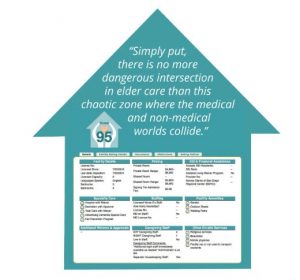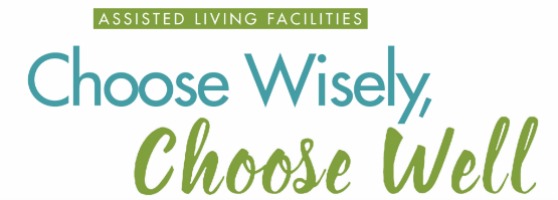Certain truths are anything but self-evident. This is the case when trying to discern truth from fiction and marketing from reality in “Assisted Living” facilities. Assisted Living (AL) and Board and Care Facilities are a popular and rapidly growing elder care option somewhere between home sweet home and the dreaded “nursing home.”
There are approximately 7,500 assisted living (AL) facilities in California. They range from small six bed residential homes to larger facilities with 100+ beds. The larger facilities typically have lovely décor and elegant ambience resembling more of an upscale hotel or country club than an institutional medical facility. Regardless of size, they all have a few things in common:
- AL’s are less expensive than skilled nursing facilities.
- AL’s are predominantly private-pay.
- AL’s are a “non-medical” model of elder care.
- AL’s are regulated by the Dept. of Social Services and Community Care Licensing (DSS/CCL). Required licensing visits are once every five years.
- AL’s have no current rating system (Like Nursing Home Compare, the Centers for Medicare & Medicaid Services (CMS) five star rating system for nursing homes) to help consumers make informed decisions when choosing an assisted living facility for their loved one.
- AL’s lack the strict regulation and record keeping the Departments of Public Health and Health Care Services require of skilled nursing facilities.
Because Assisted Living facilities are “non-medical” models of care not requiring nurses or any medically trained personnel onsite daily, this disconnect can create real problems for those residents with multiple complex and chronic medical issues.
Simply put, there is no more dangerous intersection in elder care than this chaotic zone where the medical and non-medical worlds collide. According to the National Institutes of Health, “Assisted Living facilities provide care to a large number of older adults including many with complex health problems. Although the most common reasons for entering AL are dementia and functional impairment, most residents (94%) have at least one chronic medical condition, with three quarters (76%) having two or more chronic conditions.”
When the average Assisted Living resident is an 87-year-old woman with multiple chronic illnesses, the terms “non-medical” and “elder care” rarely belong together.
Catherine Hawes, Director of the Program on Aging and Long Term Care Policy at Texas A&M, identifies the “hospitality myth.” “They (families) don’t have realistic expectations … they walk into the (Assisted Living) facility, and they’re guided through by the marketing person who makes a lot of promises about what’s available. They see the spiral staircase. They see the oriental rugs. They see the plants. They see the tai chi class and they think: ‘This is great … Mom will have her own room, her own half bath … She can bring her own furniture.’ It’s what I would like. I just want to have a nurse there and I want to have enough staff, and families don’t know to ask that question: What’s the staffing level? What’s the staffing level during the day? What’s the staffing level at night? And what’s the supervision like? Who’s passing the medications? They don’t realize it’s not a nursing home. It doesn’t have skilled nursing care.”
The reality of this lower level of care may hit them with a midnight call that Mom got confused and wandered off the premises and is now lost. Or the report might be that Mom has fallen and broken a hip, or that she’s been sent in an ambulance to the emergency room because of (you later discover) a problem in administering her medications.
Nonetheless, assisted living is increasingly attractive to frail elders and their families who just want to maintain independence and quality of life for as long as they can. In accommodating this consumer demand, the system struggles to reconcile its paradoxical mandate to combine their non-medical model with the medically fragile elders they serve.
About a year ago, I met two extraordinary women working to improve consumer access to information about Assisted Living and board and care facilities. Gerontologists and researchers Chris Murphy, MS and Christina Selder, MS from Consumer Advocates for RCFE Reform (CARR) began a partnership in 2015 with the County of San Diego. The goal: to design a robust and responsive methodology aimed at placing better information in the hands of the consumer.
The “Choose Well” program is the result of their collaboration. It is the first rating system of Assisted Living and Board and Care facilities of its kind in California, and the first by a county in the U.S. The Choose Well program is a guide to selecting a residential care facility on a website where the information can be easily accessed.
Together, Assisted Living and Board and Care facilities are referred to in the law as “Residential Care Facilities for the Elderly or “RCFEs.” County Supervisors Dianne Jacob and Greg Cox wanted to assist San Diegans with their search for good RCFEs. The Board of Supervisors wanted a ‘grading system’ that would identify quality facilities. The Choose Well program meets these goals, and has:
- A Website containing a directory of all RCFEs in San Diego County.
- A Rating or Scoring device based on facility public records data.
- 11 Quality Measures against which all facilities are scored.
- A Facility Search so families can locate facilities or a Choose Well volunteer in their zip code, city, etc.
- A program free to providers and consumers, and participation in the program by providers is strictly voluntary.

The Choose Well website (www.choosewellsandiego.org) includes resources and links for the consumers to learn about the Assisted Living care model, about resident rights, and a FAQ section to answer questions consumers might have about the program.
Choose Well volunteers receive a Facility Profile Page which allows them to distinguish themselves through a description of their care philosophy. They may describe their services and amenities, display their Choose Well score and how they have performed on the 11 Quality Measures, and identify their community affiliations. Choose Well is just getting off the ground, with new RCFEs being added to the website weekly. Over time, this innovative County program aims to become the go-to site for consumers, allied professionals, and any organization making placement referrals.
While Choose Well may not solve the medical/nonmedical paradox, it is a very good start to accommodate growing demand by consumers for transparency and accountability. There is hope that Choose Well will facilitate an evolving dialogue by educating consumers about these issues so critical to all.
So choose carefully. “Choose Well.”


